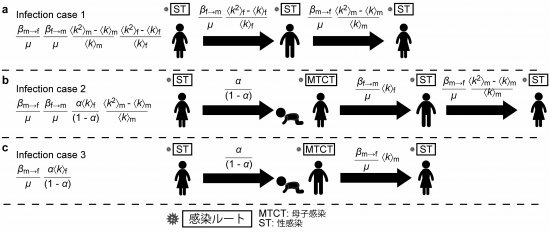2019年02月12日
熱帯医学研究所 伊東啓助教らが複雑ネットワークと母子感染を同時に考慮した性感染症の数理モデルを発表しました
| 熱帯医学研究所 国際保健学分野の伊東啓助教(テニュア・トラック)と山本太郎教授は静岡大学工学部の守田智教授と共に、複雑ネットワークと母子感染を同時に考慮した性感染症の数理モデルを開発し、その成果が2018年12月13日に『Applied Mathematics and Computation』誌からオンライン公開されました。 性感染症は主に、性感染と母子感染の2つのルートで感染を広げます。これを踏まえた性感染症の拡散を再現する数理モデルを構築できれば、効果的な拡散防止戦略を提案することができます。本研究では世界で初めて、性接触の複雑ネットワークを踏まえた性感染と母子感染を同時に考慮し、世代を超えて感染を広げる性感染症の拡散予測を可能にするモデルを開発しました。既存の研究で示された性接触頻度をモデルに導入したところ、一人あたりの感染者が生み出す2次感染者数の平均値を意味する基本再生産数は性感染に大きく影響を受けましたが、意外にも母子感染はほとんど寄与しませんでした。この結果は、母子感染予防だけでは感染症の蔓延を抑制することができないことを示しています。一方、モデルによれば常に母子感染由来の感染者が存在するので、母子感染を防止することの重要性を否定するものではありません。このモデルはHTLV-1やHBVといったウィルス性の性感染症の拡散予測に役立つと期待されます。 Hiromu Ito, Taro Yamamoto and Satoru Morita. Demography of sexually transmitted infections with vertical transmission. Applied Mathematics and Computation 348: 363-370, 2019 Abstract Sexually transmitted infections (STIs) are an ongoing public health concern. Despite many efforts, STIs have not been eradicated. Most STIs are infected through “horizontal” sexual contact and “vertical” mother-to-child transmission. We therefore need to explore the mathematical relationship between horizontal and vertical transmissions, which is necessary for the strategic eradication of STIs. Here, we constructed a simple model to demonstrate the infection dynamics of STIs with vertical transmission. We proposed a new formulation of the basic reproduction number (R0) for STIs over generations, and showed that vertical transmission exerts a smaller effect on the R0 than horizontal transmission. We also performed agent-based simulations to validate our theoretical predictions. https://www.sciencedirect.com/science/article/pii/S0096300318310439#bib0006 |
|
※クリックで拡大 |






 受験生
受験生 在学生
在学生 卒業生
卒業生 保護者等
保護者等 地域・一般
地域・一般 企業・研究者
企業・研究者 教職員
教職員
